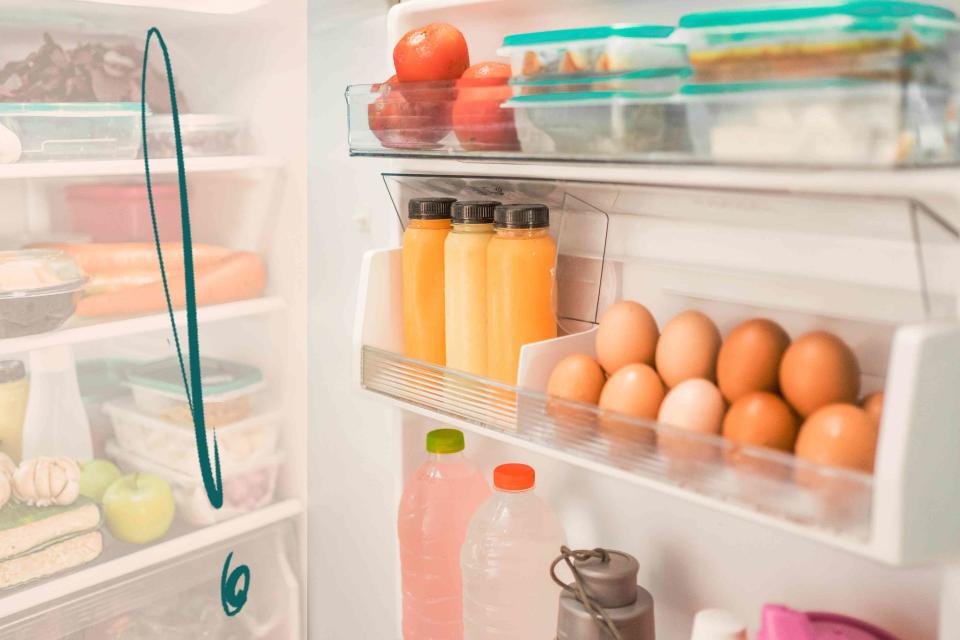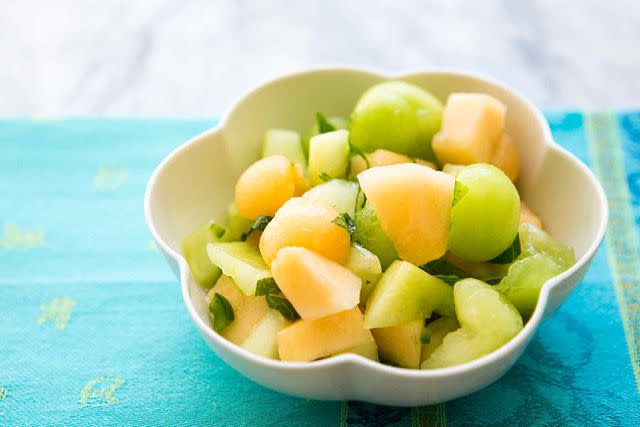The 4 Foods You Should Never Store in Your Fridge Door
Food safety experts and registered dietician nutritionists agree it's not safe.

Simply Recipes / Photo Illustration by Wanda Abraham / Adobe Stock
Salad dressing, soy sauce, mustard, and jars of olives and pickles are some of the regular inhabitants of my refrigerator door. As a registered dietitian nutritionist, I know what foods belong in the door and which ones should be stored elsewhere in the fridge. Find out why the door isn’t the ideal place for everything and the four foods you should never keep there.
Why the Fridge Door Is a Tricky Spot to Store Certain Foods
Nothing is inherently wrong with the fridge door, it’s a fine place for storing certain foods. However, since the fridge door is always being opened and closed, it’s considered the warmest spot in the refrigerator.
“Items stored in the door have more opportunities to be exposed to the higher temperatures of the kitchen,” says Kate Reeder, MCN, RDN, Certified ServSafe Instructor. “When the refrigerator is opened frequently and for longer periods of time than necessary, it’ll have a harder time keeping things cool, especially those items stored in the door.”
That means you should keep highly perishable foods—ones that need to be kept at a lower temperature at all times—out of the door and inside the main compartment. Use the door for foods that aren’t as perishable, ones that can handle the temperature fluctuation. Foods like condiments, pickles, olives, water, soda, and even juice are good candidates.
Now it’s time to address what shouldn’t go in the fridge door. The food safety experts I interviewed agree that the following four foods should always be on the shelves of your fridge and never in the door. The list might be surprising since many refrigerators come equipped with dedicated storage in the door for some of these items.

Simply Recipes / Getty Images
1. Eggs, Milk, and Dairy
The Centers for Disease Control and Prevention (CDC) advises consumers to store eggs, milk, and other dairy products at 40°F or below. The only place that can consistently remain at or below that temperature is inside the fridge, not in the door.
Culinary nutritionist Laura M. Ali, RD says that “even though many refrigerators have fancy door compartments designed specifically for eggs and milk, these items should never be stored in the door.”
Ali recommends storing eggs in their original carton on the middle or bottom shelf, towards the back of the refrigerator to ensure they stay cold. As for the milk, “utilize your refrigerator’s split, adjustable shelves to create the perfect place in the middle of the fridge, towards the back, for storing your milk.”
2. Meat, Poultry, and Fish
Raw meat, poultry, and fish don't belong in the door of your fridge. According to the U.S. Department of Agriculture (USDA), they should be stored at 40°F or below at all times. Raw meat will spoil easily if kept above those temperatures.
Lauren Harris-Pincus, MS, RDN, founder of NutritionStarringYOU.com, and author of The Everything Easy Pre-Diabetes Cookbook agrees that the shelf life of fresh animal proteins is relatively short, so stay safe and avoid expensive food waste from prematurely spoiled meat.
Raw animal proteins also have the potential to cross-contaminate foods on the same shelf or below, says Katie Schimmelpfenning, RD, and founder of Eat Swim Win. Store raw meat in the main compartment of the fridge, on the lowest shelf, preferably in a pan or other vessel with sides to contain potential juices running over.

3. Cut Produce
Are you storing cut fruits and vegetables in your refrigerator door? If so, Reeder recommends you stop.
“Certain cut fruits and vegetables, specifically melons, tomatoes, and leafy greens, are considered higher risk foods.” That’s because once cut, they are more susceptible to bacterial growth due to a combination of factors such as pH levels, higher temperatures, and moisture content. They’re high-risk foods because they have been linked to foodborne illness outbreaks in the past.
Store them in airtight food-safe containers in the main compartment of your refrigerator.
4. Leftovers
Leftovers might be a gift to your future self—but they don't last forever. To help them last the recommended three to four days before enjoying or tossing, keep them in the main compartment of your refrigerator, and not the door.
Like cut produce, they are highly susceptible to bacterial growth, and keeping them below 40°F is the safest way to store them.
Investigate What's Inside Your Fridge Door
Now that you’re inspired to make changes, consider cleaning out and organizing your refrigerator door. If you have peanut butter, honey, coffee beans, or anything that says it doesn’t need to be refrigerated after it’s opened, it doesn't need to be in the fridge at all—place them in your pantry. While you’re there, open jars to make sure there isn't any visible mold growing inside, and toss any expired food. You'll make more space for that special condiment you've been eyeing.
Read the original article on Simply Recipes.

